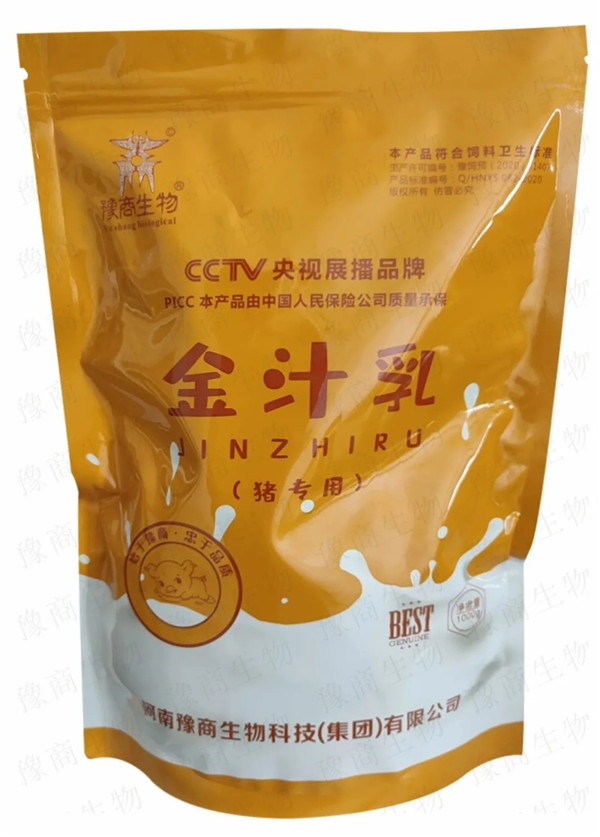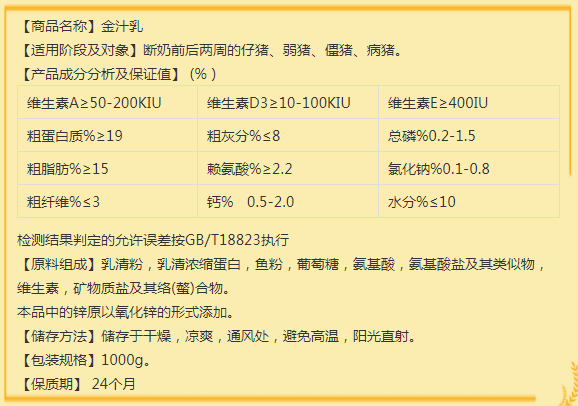

Usage: Use dry and wet methods
1. Wet feeding method: First, control the water to encourage piglets to eat the golden milk wet mixture as soon as possible. Wet mix the mixture according to the ratio of 1:3 of this product to water, or use it to brew Congee with warm water according to the ratio of 1:5 of this product. Feed the wet mixture 5-6 times a day. Or fed with piglet feeders. For piglets who are hesitant to feed, manual intervention or gavage can be used.
2. Dry feed feeding method: Use this product alone for feeding, or use it in combination with teaching trough feed
3. According to the health status and feeding habits of piglets, gradually transition to teaching trough feeding
Spring Pig Disease Prevention and Control Guidelines
1、 Strengthen the diagnosis and monitoring of epidemics
Various diseases such as foot-and-mouth disease, swine fever, porcine reproductive and respiratory syndrome (porcine blue ear disease), swine influenza, porcine pseudorabies, porcine infectious gastroenteritis, and epidemic diarrhea are prone to occur and spread in spring. Pig farms should strengthen clinical inspections and health monitoring of pig herds, promptly detect diseased pigs, and quickly eliminate potential epidemic risks. Collect clinical samples of diseased and dead pigs for laboratory diagnosis and testing. Once an epidemic is detected, it should be reported as soon as possible according to the procedure, and measures such as isolation and disinfection should be taken as soon as possible to prevent the spread of the epidemic.
2、 Make good use of vaccines and immunization methods
Vaccine immunization can be used to prevent diseases such as foot-and-mouth disease, swine fever, pseudorabies, infectious gastroenteritis, and epidemic diarrhea in pigs. The pig farm should develop a scientifically applicable immunization program based on the epidemic characteristics of the disease, select qualified and reliable vaccine products, and strictly follow the usage and dosage specified in the instructions for immunization.
3、 Strengthen hygiene and disinfection measures
Disinfection can reduce and eliminate the pollution of pathogenic microorganisms in the environment, and the frequency of disinfection can be appropriately increased in spring. The pig farm should establish a regular disinfection system, regularly replace and add disinfectant in the disinfection pool at the entrance and exit of the gate, disinfect the roads around the pig farm 2-3 times a week, and disinfect the roads and environment inside the pig farm once a day. Under the premise of safety and control, disinfect the delivery room, nursery, and growth and fattening house with pigs 2-3 times.
4、 Strengthen biosafety management
Pig farms should restrict the entry and exit of unrelated personnel, and strictly implement hygiene systems such as changing clothes, shoes, disinfection, and showering for pig farm personnel. Foreign vehicles and other transportation vehicles are not allowed to enter the pig farm. Vehicles and other transportation vehicles entering and exiting the pig farm should be thoroughly cleaned and disinfected. Strictly control the movement of personnel, vehicles, items, and pigs within the premises. Establish a biosafety system that is in line with the actual situation of the site and strictly implement it.
5、 Carry out harmless treatment of diseased and dead pigs
The arbitrary handling of diseased and dead pigs, their excrement, as well as pollutants such as bedding, packaging, and containers, not only causes the large-scale spread and long-distance transmission of pathogenic microorganisms, but also may lead to a continuous vicious cycle of the epidemic in the breeding farm, causing deep pollution of the breeding environment. Harmless treatment should be carried out on dead pigs, excrement, pollutants, etc., and they should not be discarded casually to prevent the spread and spread of pathogenic microorganisms.
6、 Strengthen feeding management
Pig farms should reasonably allocate feed according to the nutritional needs of pigs at different growth stages, with timing and quantification. Ensure fresh feed without mold and clean drinking water. Avoid scaring pigs and reducing stress during vaccination and administration. Timely remove feces and urine from the pigsty. Scientifically adjust the density of pig herds, strengthen ventilation and air exchange in the pigsty, ensure fresh air inside the pigsty, and pay attention to cold and warm protection.
7、 Perform medication prevention and healthcare
Sudden changes in temperature, changes in feed, and other stress factors can lead to a decrease in the immune system of pigs. Pig herds are prone to bacterial diseases such as Haemophilus parahaemolyticus, porcine infectious pleuropneumonia, porcine eperythrozoosis, and piglet paratyphoid fever. The key to preventing and controlling these diseases is to do a good job in drug prevention and health care for pig herds, selectively adding safe and effective antibiotics to feed or drinking water at different stages of pig production (lactating piglets, conservation pigs, growing and fattening pigs, and sows).
 微信扫码 关注我们
微信扫码 关注我们

24小时咨询热线18838966686

移动电话13733815081
Copyright © 2024 All Rights Reserved. 地址:888 Leifeng Avenue, Yuelu District, Changsha, Hunan 豫ICP123456 XML地图